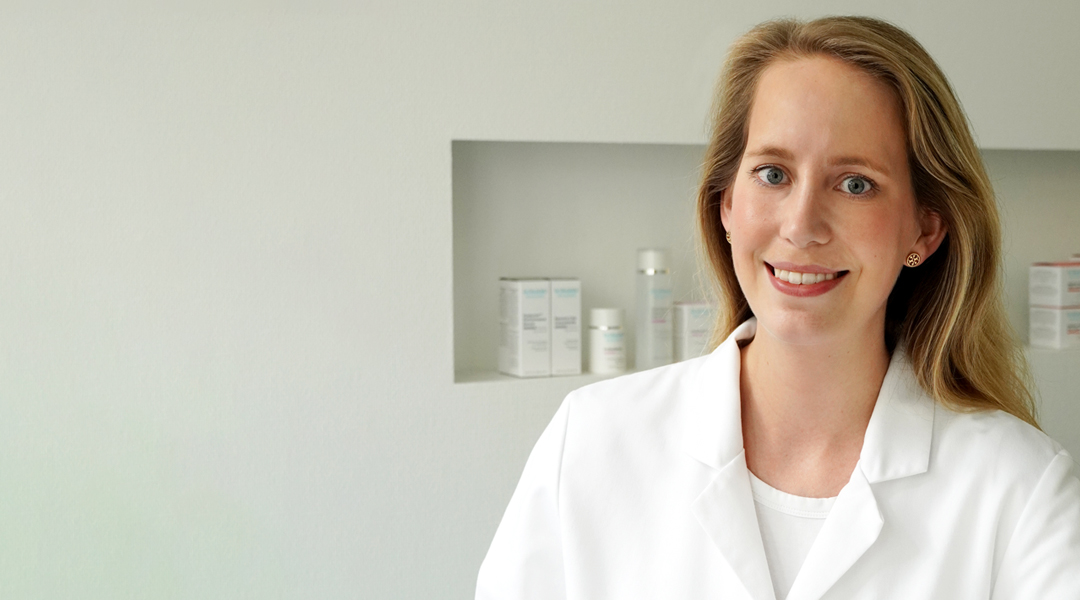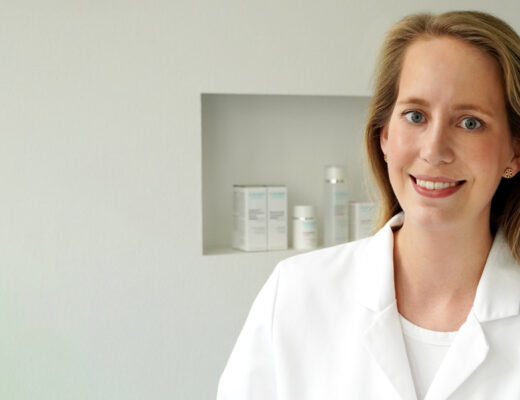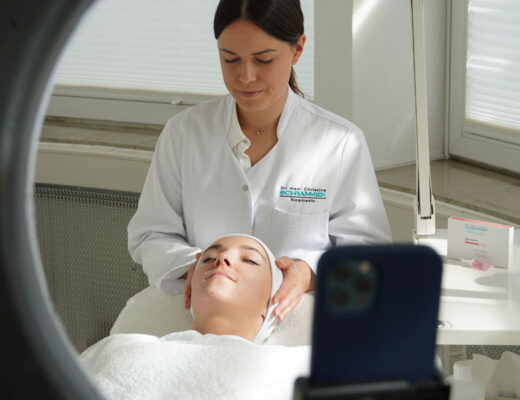Today: All about Acne!
As a specialist in dermatology and venereology, Christina Drusio brings valuable impulses to the development of medically inspired care products. In the interview series “Consultation Hour”, the topic this time is acne. Look forward to personal insights and expert tips!
Why is acne such an important issue?
Christina Drusio: Acne is a common and serious problem. Worldwide, more than 80% of all young people suffer from acne-related skin changes. This is accompanied by a certain amount of suffering, as the changed skin is clearly visible and the proportion of those affected with adult acne is also steadily increasing. Finally, many of us now have additional problems with our skin due to the constant wearing of masks, keyword maskne. So, the expectations on cosmetics but also on dermatologists are very high, to achieve a quick improvement of the skin without leaving permanent skin changes.
What causes acne?
Christina Drusio: The answer to this question is not so short, but I do my best. Basically, there are four factors that influence the development of acne, and they all go hand in hand or build on each other. Therefore, we speak of the four pillars of acne development: the basis is an excessive production of sebum in the sebaceous glands. There are many causes for this, from a genetic predisposition (activity and number of sebaceous glands are determined) to personal factors such as age and gender to lifestyle and of course hormones. The more sebum that comes out of the pores, the more they are stretched, widen, and seem enlarged. In the course, a cornification disorder occurs at the sebaceous gland hair follicle (functional unit of sebaceous gland and hair follicle) with the formation of a horny sebum plug. There is a bacterial (over)colonisation of the skin in the closed hair duct and then an inflammatory reaction occurs in the tissue with the formation of pustules and papules.
Are there also external causes of acne of acne that we can perhaps influence ourselves?
Christina Drusio: There are not so much external causes, but certainly external co-factors that play an important role in acne. An unhealthy lifestyle, stress and psychological problems do not exactly contribute to skin health. Smoking can also promote acne, as cigarettes contain many pro-inflammatory substances. When it comes to diet, we should pay particular attention to foods that cause our blood sugar level to rise sharply (foods with a so-called high glycaemic index), such as white bread, and excessive consumption of dairy products is also unfavourable. To put it simply, these foods increase the release of certain hormones in the body (insulin and insulin-likegrowth-factor-1), which lead to the promotion of growth signals. The result is increased sebum formation and increased keratinisation in the sebaceous gland hair follicle. In addition, some medications such as hormones and vitamin B preparations can also have a positive effect on acne. Finally, even certain cosmetics can promote acne, especially if they are comedogenic. This means that the cosmetics contain ingredients that can promote the formation of comedones, such as coconut oil. This can lead to acne cosmetica.
You just spoke about acne cosmetica, what other types of acne are distinguished?
Christina Drusio: This is another matter about which I could tell novels!
The most common classification of acne is according to the predominant skin changes. Acne comedonica describes acne in which there are mainly open and closed comedones.
In papulopustular acne, as the name suggests, there are mainly papules and inflammatory pustules (pimples) in addition to the comedones. The most severe form of acne is acne conglobata, which is associated with deep-seated inflammation, abscesses and fistula formation and therefore always belongs in the hands of a dermatologist! Other well-known forms of acne are acne cosmetica, caused by comedogenic cosmetic products, and adult acne (acne tarda). In addition, there are, for example, the acne forms in new-borns and small children, contact acne, medication acne, mallorca acne and scratch acne, which are generally less well known.
What treatment options are there for acne?
Christina Drusio: Physicians distinguish between external (topical) therapies and internal (systemic) therapies, which are mainly anti-comedogenic, anti-inflammatory, keratolytic and antimicrobial. External options include prescription creams or gels containing active ingredients, which are often used for mild to moderate forms of acne. For severe forms, antibiotics, hormones such as the pill, or retinoids (vitamin A derivatives) can be used internally. Cosmetic treatments should be carried out on a regular basis and the right skin care with the right active ingredients is also extremely important to improve the skin’s appearance and to maintain it in good condition in the long term.
What can be done specifically in cosmetics for acne?
Christina Drusio: As with every good cosmetic treatment, the basis is a detailed customer questionnaire (anamnesis), where you get important information about the co-factors of acne and previous skin care, and then a good skin diagnosis. The cosmetic treatment goals are all based on the causative factors, i.e., the four pillars of acne, which is why it is so important to understand what causes acne. The focus is on; reduce skin sebum, remove hyperkeratosis, eliminate impurities during cleansing and anti-inflammatory work.
At the same time, it is important to strengthen the skin barrier and maintain skin hydration! In the case of highly inflammatory efflorescence’s or after a lot of cleansing, it is better to carry out a manual lymphatic drainage instead of the classic massage. Special treatments such as fruit acid peelings or natural peeling cures are ideal.
With the GREEN PEE® herbal peeling cure, all cosmetic treatment goals can be achieved at the same time, as follicular hyperkeratosis are removed and comedones and impurities are eliminated, anti-inflammatory and sebum-regulating work is carried out, the resorption of inflammatory skin changes, even of deeper-lying infiltrates and nodes is promoted, the skin is cleansed, and the pores are refined. Even post-inflammatory hyperpigmentation and already existing acne scars can be improved.



